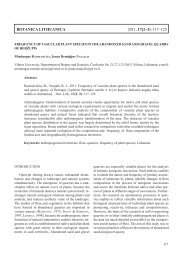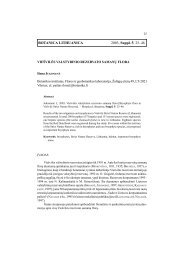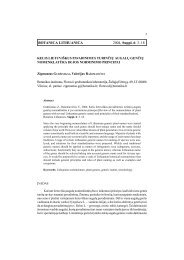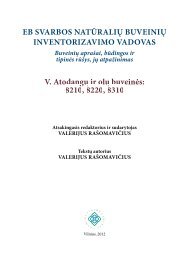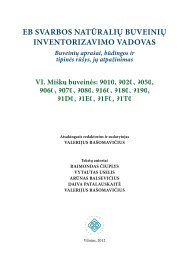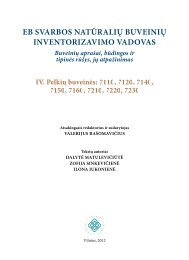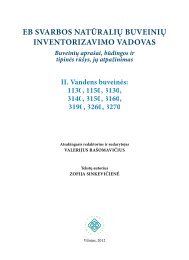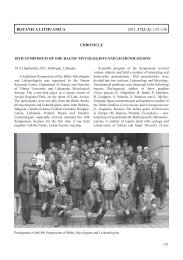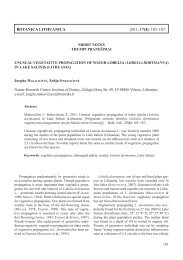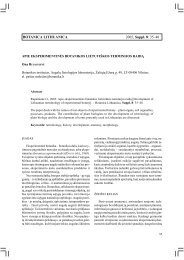FUNGI AND LICHENS IN THE BALTICS AND BEYOND XVIII ...
FUNGI AND LICHENS IN THE BALTICS AND BEYOND XVIII ...
FUNGI AND LICHENS IN THE BALTICS AND BEYOND XVIII ...
You also want an ePaper? Increase the reach of your titles
YUMPU automatically turns print PDFs into web optimized ePapers that Google loves.
Rare species in pine and mixed forests in urban areas: Geastrum pectinatum,<br />
Geastrum rufescens, Geastrum schmidelii, Gymnopilus spectabilis, Leucopaxillus gentianeus,<br />
Melanoleuca verrucutipes, Sparassis crispa.<br />
Rare and characteristic species in dunes and humid dune slacks: Agaricus devoniensis,<br />
Geastrum minimum, Hebeloma dunense, Hebeloma leucosarx, Inocybe halophila, Inocybe<br />
paludinella, Inocybe serotina, Inocybe squarrosa, Macrolepiota excoriata, Peziza arenaria,<br />
Phallus hadriani, Psathyrella ammophila, Rhizopogon obtextus, Rhizopogon roseolus,<br />
Sepultaria arenicola, Suillus flavidus, Tremiscus helvelloides, Tulostoma brumale.<br />
DISTRIBUTION <strong>AND</strong> FRUCTIFICATION OF A RARE ASCOMYCETE<br />
SARCOSOMA GLOBOSUM <strong>IN</strong> LITHUANIA<br />
M. GIMBICKAITĖ, E. KUTORGA<br />
Department of Botany and Genetics, Vilnius University, M. K. Čiurlionio Str. 21/27, LT-<br />
03101 Vilnius, Lithuania<br />
E-mails: migle.gimbickaite@gmail.com, ernestas.kutorga@gf.vu.lt<br />
Sarcosoma globosum (Sarcosomataceae, Pezizales, Ascomycota) belongs to the rarest<br />
fungi of Lithuania and as an endangered species is listed in the Red Data Book of Lithuania<br />
(1(E) category). Only three documented localities of this ascomycete were known until 1960.<br />
During 2008–2009 the species was recorded again from three new localities in the<br />
northeastern part of Lithuania. The aim of this study was to evaluate three S. globosum<br />
populations by examination of spatial distribution, number and maturity of ascocarps.<br />
Investigation on S. globosum ascocarp biology was carried out in 2009–2011 at each<br />
of the three currently known localities: Žiliškės forest (Panevėžys district), Antazavė forest<br />
(Zarasai district) and Vyžiai forest (Utena district). The fungus started to produce ascocarps in<br />
the second part of March and the first part of April, during or just after the snowmelt. The end<br />
of fructification occurred in the second part of May and first part of June. The development of<br />
individual fruiting bodies lasted up to two months. Total number of fruiting bodies and spatial<br />
distribution varied in different localities. During three years period in Žiliškės forest 10<br />
ascocarps were observed in ca. 400 m 2 area, in Antazavė forest – 6 in ca. 2500 m 2 , and in<br />
Vyžiai forest – 112 in ca. 100 m 2 , respectively. S. globosum exhibited annual fluctuations in<br />
the fruiting patterns in two localities, while in Žiliškės forest it fruited annually. Major part of<br />
ascocarps withered before reaching maturity in all populations. Mature ascocarps, i.e. those<br />
bearing ascospores, were observed in May and only from two localities (Žiliškės and Vyžiai<br />
forests).<br />
PRELIM<strong>IN</strong>ARY NOTES ON PYRENOMYCETOUS <strong>FUNGI</strong> OF MIXED FOREST <strong>IN</strong><br />
<strong>THE</strong> NORKAIČIAI BOTANICAL RESERVE (LITHUANIA)<br />
E. GUDELIŪNAITĖ, J. RUKŠĖNIENĖ<br />
Department of Botany and Genetics, Vilnius University, Čiurlionio Str. 21/27,<br />
LT-03101 Vilnius, Lithuania<br />
E-mails: Egle.Gudeliunaite@gmail.com, Jone.Rukseniene@gf.vu.lt<br />
The material was collected during field trips in May–July and September–November,<br />
2010 in the mixed forest, Norkaičiai Botanical Reserve (quarter 67), Šilutė district (western<br />
Lithuania).



